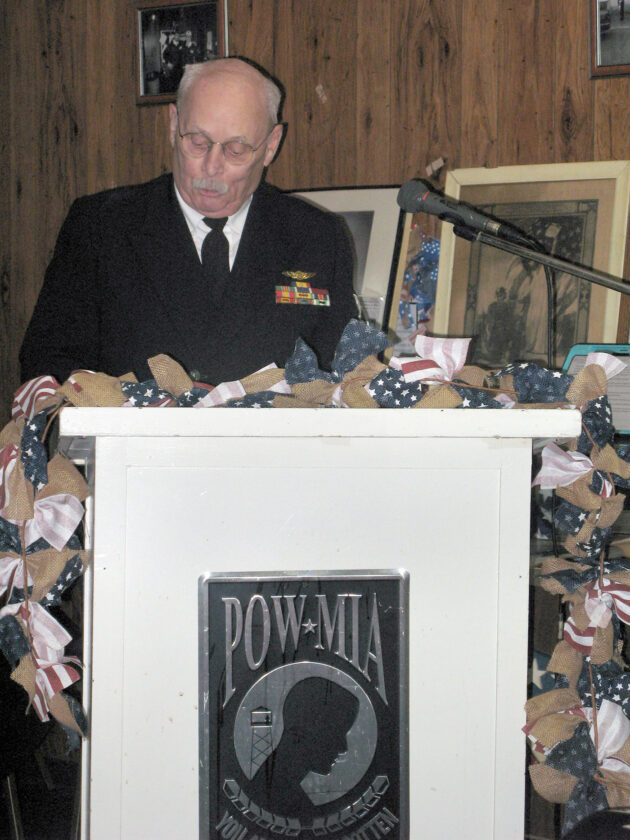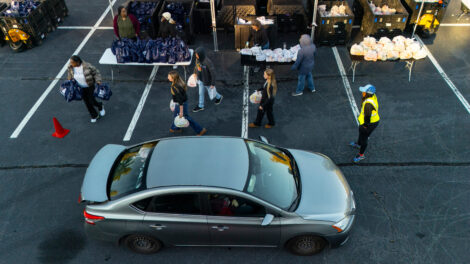VOICES OF VALOR: Brockman had long, varied military career

Warren Scott EXPRESSING GOALS — At a Veterans Day program held by Follansbee American Legion Post 45, Brockman discussed efforts by the American Defenders of Bataan and Corregidor Museum and Education Center to preserve the history of servicemen captured while defending the Philippine Islands against Japanese invasion as well as that of American veterans of other periods.
WELLSBURG — The executive director of the American Defenders of Bataan and Corregidor Museum and Education Center said like many veterans, his military experience, “wasn’t like in the movies. You don’t realize that until they tell you what to do.”
Jim Brockman’s 10-year career in the Navy included 36 months of service in Vietnam and training as a reconnaissance pilot in San Diego, Calif.
Through the museum, Brockman has worked to share the real-life experiences of American veterans, not only those who were captured while defending the two Philippine islands against Japanese invasion, but also many who served elsewhere during World War II and in other periods of our nation’s history.
The museum occupies a large room and a smaller room in the Brooke County Public Library.
A native of McDonald, Pa. and artist specializing in photography, Brockman first learned of the museum while selling some of his work at the Wellsburg Applefest.
The late George Wallace, then editor of the Brooke County Review, had some artifacts for the museum in his Wellsburg office.
As editor of The Quan, a newspaper established by a nationwide group of World War II veterans who had served in the Philippine Islands, Wallace also assisted his wife and then Brooke County library director, Mary Kay; and Ed Jackfert, the museum’s founder; in expanding an exhibit at the library that Jackfert and his wife, Henrietta, had established.
When a position as the museum’s director became open, Brockman jumped at the chance.
He recalled members of the museum’s board asking if he was familiar with the islands of Bataan and Corregidor and explaining that he had been on both while serving in the Navy.
Brockman said when he was drafted in 1966, his mother suggested he enlist in the Navy in hopes he would avoid the fighting then occurring in Vietnam.
While in high school, he was one of a few male students at the time to sign up for a course in typing. He proved to have a flair for the skill, developing the ability to type about 80 words per minute.
While completing boot camp training at Camp Moffatt in Illinois, an officer learned of his typing ability and assigned him to complete daily reports for the brigade inspector for six weeks.
“I had privileges nobody had as long as I kept the brigade inspectors in line,” he noted.
For example, he wasn’t required to undergo the drills other new recruits had or to wash his own clothes and could consume Coca-Cola on a weekday, which was limited to weekends for other enlistees.
The experience was short-lived, however, as he was soon assigned to attaché duty in Barcelona, Spain.
Brockman said one day he was called to his base’s personnel office, where he was given a card explaining his rights, under the Geneva Convention, should he be captured by enemy forces.
Soon after Christmas 1967, he was aboard the USS Tanner off the coast of South Vietnam.
Brockman recalled he and others set out for supplies in a landing craft in an area of the Mekong River not considered hostile when they encountered enemy fire.
“The V.C. (Viet Cong) opened up on us and I lost my helmet,” he said.
Brockman said while no one was harmed, “By the time we got back to the boat, we were pretty wet and shook up.”
He had been a ham radio operator as a youth and knew Morse Code, so he was chosen to serve as a radio operator.
He said while in the field, his radio was about the size of a small suitcase with straps so it could be carried on his back.
“I was told, ‘Knock that stupid antenna down. That’s what they (enemy snipers) look for,” he said.
U.S. forces were building base camps in the region, and he was part of a geological survey for that.
“We were commended for conducting the largest survey of the Mekong River, which was a couple thousand square miles,” he noted.
Brockman’s next assignment was to the USS Conserver, which was charged with recovering downed aircraft and damaged ships near Guam.
Of the vessels Brockman said, “They could patch them up and make them run again.”
He noted service in Vietnam for the Navy was longer than that for the Army and Marine Corps, which supplied ground troops for the war.
Brockman served three tours of duty, a total of 36 months, and returned to the U.S. between them.
Asked if he was aware of public sentiment toward the war during those visits.
“We got spit on a few times at the airport. They called us baby killers and stuff, which is hard on some of these guys,” Brockman said.
He noted after returning to the U.S. and California, he never wore his uniform off base.
Brockman said for a time following his return from Vietnam, he was involved with burial duty, in which he and others folded a U.S. flag and presented it to the survivors of a deceased fellow sailor.
He said on those occasions he was sure his uniform was neat and the flag was properly folded.
“You wanted to be sharp as a tack because you wanted to honor that guy,” said Brockman.
His next assignment involved training at the Naval Fighter Weapons School, the equivalent then of the pilot training program seen in the movie, “Top Gun.”
“But it’s not like the movie,” stressed Brockman.
He noted the flying stunts performed by Maverick and other characters in that popular film would be strongly discouraged by commanding officers for the excessive wear they caused on their very costly aircraft.
But Brockman said he enjoyed flying a P3 Orien, a turboprop surveillance aircraft.
“It would jump off the deck (of an aircraft carrier) at 80 knots if you let it. I loved that plane,” said Brockman.
He said aviation school had involved many hours of training, including a year’s worth of trigonometry instruction in 11 days.
“The aviation branch is highly technical. You pretty much had to know every part of that plane related to what you were doing,” said Brockman.
He also underwent the photo interpreter training he would need while flying unarmed photo reconnaissance missions around the Mediterranean Sea in the 1970s.
Photo-interpreters are charged with taking photos of various subjects and assessing them for military intelligence.
The test for a photo interpreter involved quickly viewing 150 photos and answering a question about each.
Brockman said he got through 147 of the questions but answered all of them correctly.
He left the Navy as a Petty Officer 2nd Class in 1977 at a time when many cuts were made to the U.S. military.
From there he went on to various teaching positions, the most recent at Slippery Rock University.
Brockman said he’s been very happy to serve as director of the museum, where he’s able to preserve the history of many veterans.
He noted his work has ranged from taking calls from authors and others researching various aspects of military experiences to leading tours for inquisitive children from local schools.
Brockman said the community has been very supportive of the museum — including donations from two local families, the Meriwethers and the Hubbards, that made it possible to expand the library, creating 2,900 square feet of display space for it.
“This is probably the best job on the face of this earth. I’ve got a great board, people who want to keep it (the museum) going and make it bigger and better,” he said.
(Scott can be contacted at wscott@heraldstaronline.com.)




